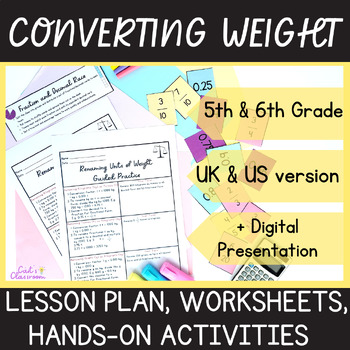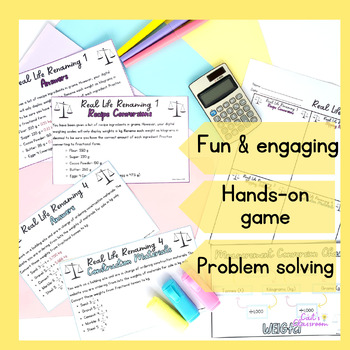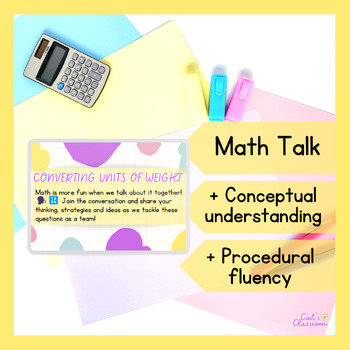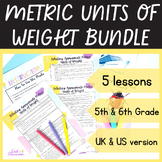Converting Metric Units of Weight│Lesson Plan Game Problems│5th & 6th Grade Math
- Zip
Also included in
- Preparing to teach metric units of weight measured in tons, kilograms and grams? Looking for step-by-step lesson plans, hands-on measurement activities, digital presentations, engaging games and practice worksheets? Then this resource is for ✨️YOU!✨️Designed specifically with newly qualified teachersPrice $13.95Original Price $19.93Save $5.98
- 5th/6th grade end of year math fun! Preparing to teach metric weight and capacity? From liters and milliliters to tons and kilograms, this unit features hands-on measurement games/activities, digital/printable resources and detailed lesson plans.Designed specifically with newly qualified teachers inPrice $29.70Original Price $45.68Save $15.98
Description
Looking for a fun, engaging lesson for fifth/sixth grade on converting/renaming metric units of weight measurement? Want it to include worksheets, problems and a hands-on game for converting tons, kilograms and grams using fractions and decimals? Then this resource is for ✨️YOU!✨️
Take the stress out of creating complete lesson plans and resources! This lesson is aligned with both CCSSM and the Irish Primary Mathematics Curriculum (2023) and contains UK and US versions for appropriate spelling. ✏️
Help your students excel in math while reclaiming your valuable downtime with this engaging, curriculum-aligned lesson plan. Grab your copy TODAY!
⭐️Benefits⭐️
✅️ Reduces planning demands on teachers, saving valuable time and effort while being well-designed and aligned with curriculum standards.
✅️ Offers a complete, print-and-go resource with step-by-step instructions, ideal for newly qualified teachers who want support teaching math to the senior grades.
✅️ Enhances conceptual understanding and procedural fluency of renaming/converting metric units of weight using fractions and decimals for accurate communication and problem-solving.
⭐️In Depth Description⭐️
This 45-minute lesson plan includes:
✅ 24 fractions/decimals matching cards (color and black &white): Offers a dynamic method for students to practice converting fractions to decimals and vice versa.
✅ Conversion chart (color and black & white): Provides a reference tool for students to easily convert between different weight units, aiding in accuracy and comprehension.
✅1 guided practice worksheet + answer key: Guides children through the conversion process at their own pace, providing structured practice opportunities.
✅ 4 real-life renaming scenarios + accompanying worksheet/answer key: Applies mathematical concepts to real-world situations, enhancing relevance and practical understanding.
✅️Math Talk digital presentation: Provides a clear focus for math discussions, encouraging student participation and collaboration.
✅️3 learning objectives: Clearly defines lesson outcomes, guiding both teachers and students in their learning goals.
✅️Differentiation strategies: Accommodates diverse learning needs, ensuring all students can access and succeed in the lesson.
✅️Assessment strategies: Provides practical guidance on assessing student understanding throughout the lesson.
✅️Key vocabulary and definitions: Equips students with essential language for effective communication about metric units of weight.
✅️Exit tickets (color and black & white): Quickly gauges student understanding at the end of the lesson, providing valuable feedback for future instruction.
✅️ Fully aligned with the new Irish Primary Mathematics Curriculum (2023), specifically the element of communicating and the competencies of being an active citizen and being a communicator and using language.
✅️Common Core aligned - CSS.MP.1, CSS.MP.4, CCSS.5.MD.A.1
⭐️Other Uses⭐️
1. Create a classroom display: Instead of only using the conversion charts as reference tools, have students work together to create a visually appealing classroom display showcasing different conversion strategies or examples of metric unit conversions. This activity promotes student ownership of their learning environment and serves as a reference tool throughout measurement-based lessons.
2. Gallery walk: Post the scenarios around the classroom and have students rotate in groups to examine each scenario. Encourage them to discuss their solutions and reasoning as they move through the 'gallery'. This interactive activity promotes active engagement with the material and allows students to learn from each other's perspectives.
3.Group challenge: Divide the class into teams and present each team with the problem solving scenarios to solve within a time limit. Award points based on the accuracy and speed of their conversions. This gamified approach adds an element of excitement and encourages friendly competition while reinforcing the concept of metric unit conversions.
➡️ Don't let this opportunity slip away! Elevate your teaching experience and engage your students - secure your complete lesson plan and resources TODAY! ⬅️
Click here to join the Cáit's Classroom mailing list for valuable tips, tricks, and special offers designed to support newly qualified teachers in effectively teaching math to 3rd-6th grade students.







